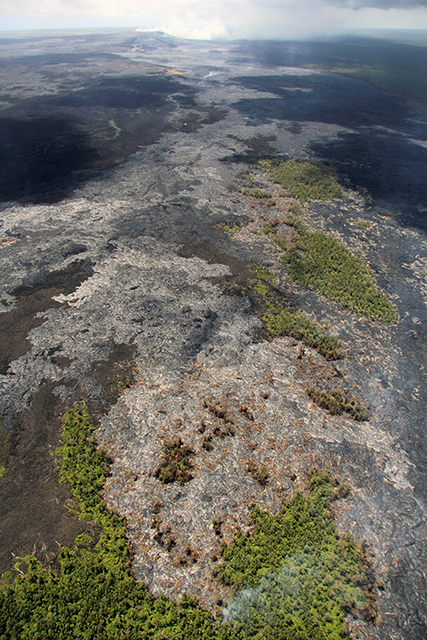Three areas of breakouts remained active in the upslope portion of the June 27 lava flow, the U.S. Geological Survey Hawaiian Volcano Observatory reported Thursday. ADVERTISING Three areas of breakouts remained active in the upslope portion of the June 27
Three areas of breakouts remained active in the upslope portion of the June 27 lava flow, the U.S. Geological Survey Hawaiian Volcano Observatory reported Thursday.
Scientists, who are using webcams to assess the flow, said that the Feb. 21 breakout remains active on the northern flank of Puu Oo, while the March 9 breakout near Puu Kahaualea continues to move toward the north. Breakouts also remained active between 3 and 4 miles northeast of Puu Oo.
There are no other areas of breakouts along the June 27 flow field located within Kilauea Volcano’s East Rift Zone, scientists said. All downslope areas remained quiet.
One of the five vents on Kilauea Volcano’s Puu Oo crater floor that erupted a small lava flow Tuesday afternoon also remained active Thursday, scientists said. It remains contained within the crater.
Tuesday’s eruption occurred about 5 p.m. and was “short-lived,” lasting no more than 30 minutes. The eruption sent lava from the vent down into a “slightly deeper center” of the crater. Click here for the full story.
Tiltmeters positioned at Kilauea’s summit did not record any significant changes during the past day. Tiltmeters are used to measure tiny changes in the slope angle or “tilt” of the ground. The volcano’s summit began inflating April 1 after appearing to have entered a deflation-inflation cycle that commenced March 30. During inflation, magma rises into the summit reservoir, according to the observatory. The summit reservoir enters the deflation portion of the cycle when the magma moves laterally into a rift zone and either erupts or is stored there.
The volcano also continued to host a lava lake at its summit.
Summit seismic tremor continued with episodic bursts accompanying spattering and temporary drops in lava level, according to HVO. Earthquake activity remained slightly elevated beneath the south summit caldera and the Southwest Rift Zone midway between the summit caldera and the ocean.
The tiltmeter on the north flank of Puu Oo recorded minor variations.
The U.S. Geological Survey Hawaiian Volcano Observatory on March 25 downgraded its alert level for Kilauea Volcano from a “warning” to a “watch.”




